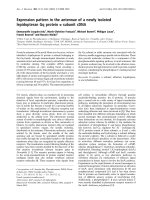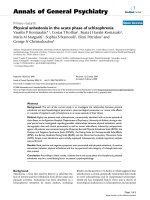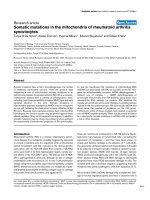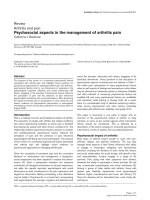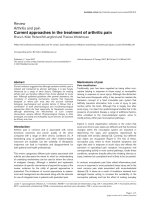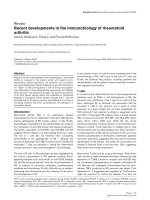Báo cáo y học: " Bet hedging in the underworld" pdf
Bạn đang xem bản rút gọn của tài liệu. Xem và tải ngay bản đầy đủ của tài liệu tại đây (235.06 KB, 3 trang )
Soil-dwelling bacteria face the challenge of maintaining
fitness in the face of frequent changes in nutrient
availability. Many species have evolved mechanisms of
food storage, which are likely to enhance survival during
periods of starvation. e classic example is production
of lipid-like poly-3-hydroxybutyrate (PHB) by bacteria in
the family of Rhizobiaceae (collectively known as
rhizobia). Rhizobia lead a dual life as both soil sapro-
phytes, living off dead organic matter, and as symbionts
of leguminous plants. As plant symbionts, they exist in
specialized organs known as nodules, where they convert
atmospheric nitrogen into ammonium for use by the
plant. Within the nodule, rhizobial activities are powered
by carbohydrates from the plant, with surplus being
partitioned to the storage compound PHB [1]. Stored
PHB - a reward from the symbiosis - can exceed 50% of
the cellular dry weight of rhizobia and is used to support
growth in the nutrient-limited bulk soil after rhizobia are
released from senescing nodules.
Before reaching the next suitable host, rhizobia must
decide how to use stored PHB. e critical but unknown
factor is the length of time before a new host is en-
countered. How should the bacterium respond? One
possibility is to use PHB as fast as possible, thus
maximizing short-term growth rate - a strategy likely to
be successful if a new host is encountered in the near
future, but disastrous if there is a prolonged period before
the next host. Alternatively, PHB could be used con ser-
vatively, thus increasing the likelihood of long-term
survival - a strategy likely to be successful if new hosts are
rarely encountered, but of limited utility if a new host is
encountered in the near future. In the face of such
uncertainty, it can pay to ‘hedge one’s evolutionary bets’:
to spread the risk of being maladapted in some future
environment among variable offspring, each of which has
a chance of being adapted to future conditions [2].
Low-PHB and high-PHB S. meliloti cells
In a recent paper, Ratcliff and Denison [3] suggest that
rhizobial cells use a bet-hedging strategy to manage PHB
storage. Under starvation conditions, cells divide to give
rise to daughter cells of two contrasting phenotypes:
high-PHB and low-PHB. Low-PHB cells are more com-
petitive in saprophytic reproduction and are thus suited
for short-term survival, whereas high-PHB cells survive
longer without nutrients and are thus suited to withstand
prolonged starvation. e authors [3] argue that co-
existence of two phenotypes ensures greater long-term
fitness, reduced variation across starvation events and
high reproductive output over many rounds of plant-to-
soil life cycles. (More specifically, they argue that it
ensures greater long-term geometric mean fitness.)
e focus of study was Sinorhizobium meliloti, the
microsymbiont of alfalfa (Medicago sativa L.), which
accumulates PHB during plant symbiosis and also during
stationary phase in laboratory medium (high- and low-
PHB variants can be distinguished by flow cytometry). By
way of support for the bet-hedging hypothesis, Ratcliff
and Denison [3] showed that under starvation conditions,
an initial population of high-PHB cells differentiates into
two distinctive subpopulations of cells: one with high and
the other with low PHB levels. ey also showed that the
phenotypic dimorphism is stable - even after more than
500 days of starvation. Microscopic analysis of dividing
high-PHB cells showed that PHB granules are allocated
asymmetrically. During cell division of rod-shaped
bacteria, the ends of a cell are designated the old and new
poles; PHB granules are preferentially retained in the old-
pole cells of S. meliloti. Furthermore, the capacity to
switch between high- and low-PHB cells was shown to be
a heritable property of individual bacteria [3].
To see whether different phenotypes confer advantages
under starvation conditions, the authors [3] compared
the fitness of high-PHB cells relative to low-PHB cells at
14 days and then again at 528 days. No difference in cell
viability was observed during short-term starvation
Abstract
Under starvation conditions, the soil bacterium
Sinorhizobium meliloti divides into two types of
daughter cell: one suited to short-term and the other
to long-term starvation.
© 2010 BioMed Central Ltd
Bet hedging in the underworld
Xue-Xian Zhang* and Paul B Rainey
R E S E ARC H H I G HLI G H T
*Correspondence:
New Zealand Institute for Advanced Study, Massey University at Albany, North
Shore Mail Center 0745, Auckland, New Zealand
Zhang and Rainey Genome Biology 2010, 11:137
/>© 2010 BioMed Central Ltd
(14 days); however, after 528 days, the survival rate of
high-PHB cells was five times greater than that of low-
PHB cells. When grown in nutrient-rich medium, popu-
lations with a larger fraction of high-PHB cells had a
significantly longer lag phase: as a consequence, popu-
lations with large numbers of high-PHB cells were less
competitive than those with low numbers of high-PHB
cells. Together, the fitness data suggest that high-PHB
cells have a survival advantage under long-term starva-
tion but a slower growth response to exogenous
nutrients, whereas the low-PHB cells seem to be primed
for rapid reproduction but are less capable of survival
during long-term starvation [3].
Is the phenotype switching an adaptation to
uctuation selection?
Although the experiments reported by Ratcliff and
Denison [3] are consistent with the hypothesis that switch-
ing between high- and low-PHB is a bet-hedging strategy,
a key issue is whether this behavior is an adaptation, that
is, whether it is an evolutionary response to fluctuating
selection shaped by natural selection. Resolving this issue -
as the authors mention - poses significant challenges [4].
Some insights, we suggest, are possible from the results of
contemporary comparative and mechanistic studies.
Central to the PHB bet-hedging model is asymmetric
cell division: unequal division on starvation generates
daughter cells with high and low levels of PHB. S.meliloti,
like the related bacterium Caulobacter cres centus (both
members of the α-Proteobacteria), is known to undergo
asymmetric cell division [5,6]. Observations from fluor-
escent microscopy show that S. meliloti cells typically
divide to produce daughter cells that vary in length: old-
pole cells are approximately 12% longer than new-pole
cells [5]. is resembles the well-studied asymmetric
division in C. crescentus in which stalked cells divide to
give rise to swarmer cells. Molecular analysis of genes
involved in asymmetric division, particularly those regu-
lated by CtrA, which upregulates many genes involved in
cell division, reveal a conserved mechanism of cell cycle
control in S. meliloti and C. crescentus - and indeed in
other members of the α-Proteobacteria [6]. For example,
in S. meliloti the cell cycle regulator DivK is localized to
one pole of the longer (old-pole) cells, but is not polarly
localized in the shorter (new-pole) cells; similarly, DivK
in C. crescentus is localized to one pole in stalked cells
but shows no polar localization in swarmer cells [5].
ese findings raise the possibility that, as in C. crescentus,
asymmetric cell division in S. meliloti is a developmentally
programmed event. As such, it calls into question the
appropriateness of the bet-hedging framework. at a
genotype produces entities with different morphologies
and fitnesses is a necessary condition for bet hedging, but
alone is not sufficient. A critical issue is evidence of a
mean-variance fitness tradeoff (a reduction in temporal
fitness variation at a cost of reduced mean fitness) [7]. A
further requirement is some evidence of stochasticity in
the underlying mechanism. Many organisms - including
bacteria - show differentiation and complex development
but would not be regarded as bet-hedging types. For
example, the production of two genetically identical but
functionally different progeny cells by C. crescentus - one
flagellated but unable to reproduce and the other a
stalked cell competent for replication - is an apparently
successful adaptation for survival in environments in
which resources are patchy [6]. Such a strategy would fit
certain definitions of bet hedging, but reference to
differentiation in C. crescentus as bet hedging makes little
sense because the strategy is fixed by development.
A further and related issue concerns the capacity for a
developmentally controlled phenotypic switch to be
tuned to prevailing environmental conditions. Simple
models [8] predict that, in organisms capable of bet hedg-
ing, the rate of switching between phenotypic states will
evolve to match the rate of environmental change.
Accordingly, for S. meliloti, it is reasonable to assume
that isolates from environments that differ in the tem-
poral and spatial patchiness of resources will show differ-
ent rates of switching. For example, S. meliloti from
resource-rich environments should evolve switching
rates that are biased toward the production of low-PHB
cells, whereas the opposite should hold for bacteria from
resource-poor environments. However, if switching is
tied to the cell cycle and subject to developmental
control, then it is difficult to see how selection could lead
to the evolution of bet hedging, let alone the tune
switching rates to suit prevailing conditions.
Further work is needed to determine whether our
alternative hypothesis - that switching in S. meliloti is
developmentally regulated and akin to a C. crescentus-
like life cycle - or the authors’ hypothesis of selected bet
hedging is the correct explanation for the observations
of Ratcliff and Denison [3]. A great strength of the work
stems from the authors’ close and detailed attention to
cellular variation. Many microbes show similar
behaviors, but rarely is the significance of such
phenotypic variation considered. Here, with focus on the
ecological signifi cance of variation at the cellular level
and its evolutionary origins, the authors [3] open the
door to new vistas in microbial ecology and evolution,
with likely far-reaching consequences.
Acknowledgements}
We thank Eric Libby and laboratory members for helpful discussions.
Published: 27 October 2010
References
1. Trainer MA, Charles TC: The role of PHB metabolism in the symbiosis of
rhizobia with legumes. Appl Microbiol Biotechnol 2006, 71:377-386.
Zhang and Rainey Genome Biology 2010, 11:137
/>Page 2 of 3
2. Seger J, Brockmann JH: What is bet-hedging? In Oxford Surveys in
Evolutionary Biology. Volume 4. Edited by Harvey PH, Partridge L. Oxford:
Oxford University Press; 1987:182-211.
3. Ratcli WC, Denison RF: Individual-level bet hedging in the bacterium
Sinorhizobium meliloti. Curr Biol 2010, 20:1740-1744.
4. Beaumont HJ, Gallie J, Kost C, Ferguson GC, Rainey PB: Experimental
evolution of bet hedging. Nature 2009, 462:90-93.
5. Lam H, Matroule JY, Jacobs-Wagner C: The asymmetric spatial distribution
of bacterial signal transduction proteins coordinates cell cycle events. Dev
Cell 2003, 5:149-159.
6. Hallez R, Bellefontaine AF, Letesson JJ, De Bolle X: Morphological and
functional asymmetry in alpha-proteobacteria. Trends Microbiol 2004,
12:361-365.
7. Childs DZ, Metcalf CJ, Rees M: Evolutionary bet-hedging in the real world:
empirical evidence and challenges revealed by plants. Proc Biol Sci 2010,
277:3055-3064.
8. Moxon ER, Rainey PB, Nowak MA, Lenski RE: Adaptive evolution of highly
mutable loci in pathogenic bacteria. Curr Biol 1994, 4:24-33.
doi:10.1186/gb-2010-11-10-137
Cite this article as: Zhang X-X, Rainey PB: Bet hedging in the underworld.
Genome Biology 2010, 11:137.
Zhang and Rainey Genome Biology 2010, 11:137
/>Page 3 of 3
